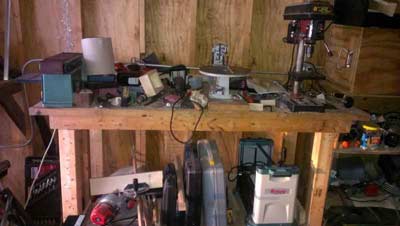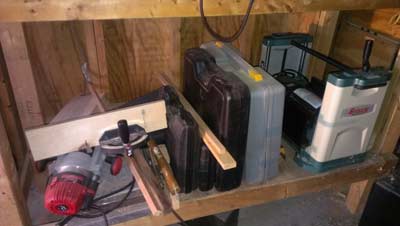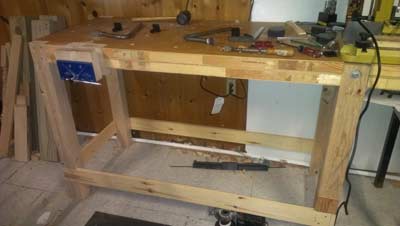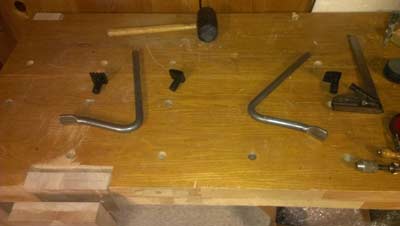How I Got Started in Woodworking
by Scott Stahl
Kankakee, Illinois
Click on any picture to see a larger version.
My woodworking bug bite happened years prior to actually purchasing 'real' woodworking tools. A small collection of tools is an inevitable fact of life for the suburban homeowner. I still have the electric drill and circular saw that arrived soon after closing on my first home; they still see use fairly often.
That small collection of homeowner tools is used to assemble toys, hang curtains, install wood trim, uninstall wood trim, install the darn trim again, build outdoor playsets, and a hundred other nameless but essential tasks.
After several years of dad and husband projects, something strange happened: my oldest son joined Cub Scouts. Did you know that Cub Scouts race little wooden cars? Furthermore, did you know that suburban masculinity is defined by these wooden wonders of gravity?
Preparing for that first Pinewood Derby race was a great opportunity for quality time with my son. We sat down and read the directions. I then asked him to pick a reference model from among the cornucopia of die cast cars in the toy box.
I helped him form the crude copy of the metal car. We painted and decorated it until it was something my son was really proud of. On race day it didn't take more than a minute to realize we just entered a Pinto into a NASCAR event. My son was so crestfallen at our dismal showing that he didn't want to touch the car ever again. By that look of disappointment, I was willingly drafted into the secret wooden car war dads wage through their children. There is even a
low budget movie
movie based on this war. The movie is a 'must see' if you are a veteran of the wooden car war.
With two sons in scouts, we've probably built a score of the pinewood derby cars. Our cars made respectable showings in the races, yet we never took the top honors. The story would make a great black and white silent film montage like the early months of human flight, or the Keystone Cops.
The derby cars generated other projects, like a test track and various jigs to keep my fingers away from the blade of my 12î Craftsmen chop saw, my chief instrument of wood mutilation for many years. Necessity drove the woodworking bug deeper under my skin. I found we needed an entertainment center for the minivan to occupy three children during long trips (works better than Benadryl, or Brandy, and has the benefit of being legal). The minivan entertainment center turned into one for the Jeep, too. Let's not forget the outdoor playset designed and built by me and three kids. Just like Genesis in the Christian bible, a long series of begats ensued until finally, I realized that I was in too deep. The second woodworking magazine subscription should have tipped me off sooner. The simple truth is that woodworking is an enjoyable pursuit with tangible useful benefits in other areas of life.
Woodworking in America 2010 really opened my eyes to a lot of things in woodworking. Here are the two biggest:
1) All my life a chisel has been an extension of a hammer. Roy Underhill taught me that a hammer is the occasional extension of the chisel. Watching him wield various chisels in the classes he taught was a real education. I sat in on repeat seminars so as to zone out on the real topic in order to concentrate on how and why the chisel was used. I have a set of Irwin Marples chisels. I like them a lot. The Irwin's are long, made of pretty good steel, and hefty enough to feel good in my big hands. Conventional wisdom is that lighter chisels are preferable for comfort during all day use; I've yet to spend 8 or more hours straight chiseling something.
2) Frank Klausz cuts dovetails. His dovetails are fast and cut by eye honed by years of practice. Frank doesn't even think of trying to achieve the precision of a router jig. His philosophy is that a hand cut dovetail needs to look hand cut so that the hand craftsmanship is easy to display. The subtext is that the folks well heeled enough to pay for hand craftsmanship want others to see and know it. I learned that dovetails need to hold wood parts together more than they need to be part of any design.
I have spent a lot of time and money to develop woodworking skills (mostly read 'tools' in place of 'skills'), yet my shop is not a pure woodworking paradise. I am still a father and homeowner and many other projects share space with the wood shop, electrical shop, networking shop, landscaping concern, and miniature warehouse known as the garage. In short, I am just like most other hobbyist woodworkers out there. All commercial outlets for woodworking knowledge gloss over this simple reality. My pragmatic approach to woodworking not only acknowledges the many demands on our space and time, it embraces it.
An article about woodworking is a cheat if there aren't any real lessons about working wood. Readers who are just starting out in woodworking can benefit greatly from the following lesson number 0; more experienced woodworkers will probably nod and smirk sagely. The first thing to know about woodworking is that the barrier of entry is actually quite low. Anyone can build a huge number of projects with only the typical homeowner's tool collection and sandpaper. Quality woodworking tools are expensive compared to the variety of tools offered at the local garden store. Let the tool collection grow with your interest in woodworking.
The first pragmatic advice based on hard lessons that I can offer is the first step to serious woodworking is work holding. Typically work holding refers to a monster bench with vises of adamantine power that costs thousands of dollars retail, but don't fall into this trap too early. The monster bench will be in your future if you take up woodworking seriously. The work surface you get now should be procured within means and built by you, but this should be your first big ticket item. Work sliding all over the place makes learning techniques far more difficult. My first bench was built from the cast offs found in the rubbish pile outside a home under construction. I have long since moved on, but that first bench (in the cluttered picture below) is still in use housing the drill press, jigsaw, metal working vise, and combination disk/belt sander.

|

|
My current bench is pictured below. It is built from two solid core doors glued and screwed together. The legs are made from 2 X 4 and leftover 4 X 4 construction lumber. There used to be a piece of plywood with landscaping bricks on it for mass. With ballast she comes in at 350 pounds. A fellow woodworker on an Internet forum recommended that I put rubber under each leg to prevent sliding. After doing so the extra mass was unnecessary. As you can see, I'm using a Frankenstein bench that is quite adequate for most of what I do. I have the lumber to build a petite Roubo style bench next.

|

|
The homework assignment for the new woodworker is to research the thousands of examples of work surfaces out there. A person really could spend weeks looking at work benches; do not dwell on the options and follow the KISS (Keep It Simple, Stupid) principle in selecting a design. Work holding is something I plan to talk about often simply because it is often overlooked in other sources of woodworking information. I look forward to sharing more of my woodworking journey in the future and especially want to hear from other woodworkers in the process.
MY BLOG, if you would like to read more about what I've been up to,
CLICK HERE
If you have any questions or comments, feel free to email me at
tsstahl@gmail.com
Return to
Wood News
front page

